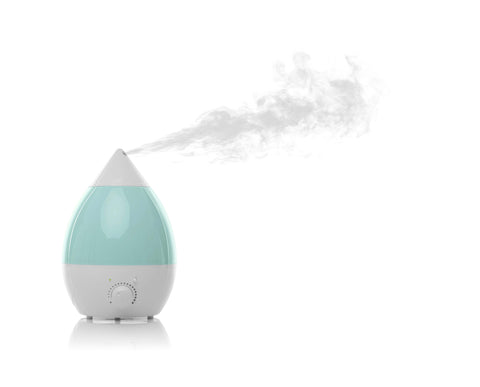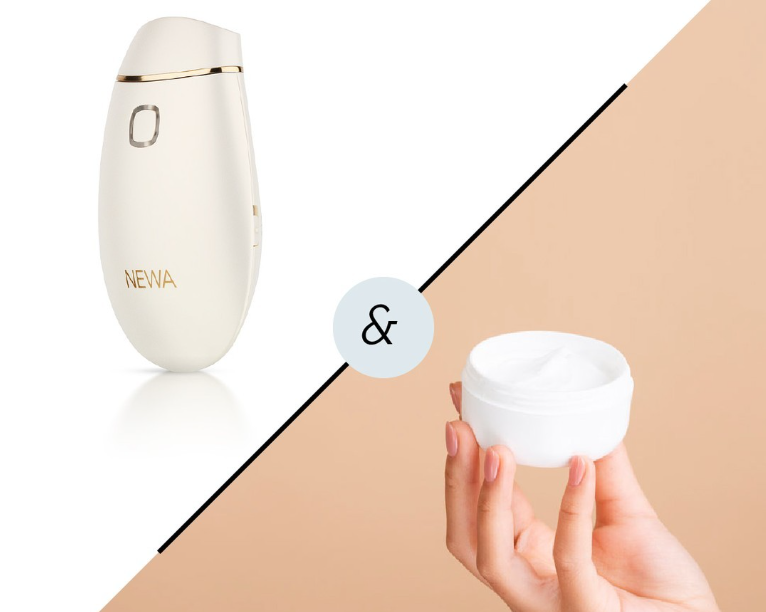The weather continues to get colder and most of us are running our heaters as we start the new year. Because of this, you may be noticing that your usual skincare routine isn’t cutting it in terms of tackling dry, flaky skin. If your skin feels tight or rough after cleansing, looks dull or flaky, or you’re noticing more sensitivity then these may be signs that your skin has been impacted by seasonal changes.

Every winter like clockwork, we get messages on social media and comments in our Facebook community asking for help with conductivity. Whether you’re using our NEWA device or other treatments like microcurrent, significant dehydration can increase the skin’s electrical resistance and make it take longer for your device to go green - which we’ve discussed previously here.
Whether you’re wanting to optimize your at-home radio frequency skin tightening treatments with NEWA or just get your skin back on track, these skincare tips will help you adjust your routine and get your skin through the winter!
Know Your Dry Skin

One of the biggest obstacles people face in addressing dry skin is not understanding what dry skin is and how it impacts the skin. This is made even more confusing by information online that perpetuates the idea that dry skin and dehydrated skin are separate issues entirely. Despite what you may have heard, dry skin is not just a static skin type - and it’s greatly influenced by environmental factors that alter skin barrier function.
Our skin barrier, the uppermost layer of the epidermis called the stratum corneum, is designed to keep moisture in and keep microorganisms, allergens, irritants, and other damaging environmental factors like UV rays out. A good analogy is the Brick and Mortar Skin Model - skin cells called corneocytes are the “bricks” and then the “mortar” would be the lipids in between that help waterproof.
The skin is carefully regulated. Dead skin cells are shed in a process called desquamation and hydration is maintained by our Natural Moisturizing Factor (the skin’s humectants) that bind water from the atmosphere. When humidity levels drop due to winter and indoor heating, dehydration can cause the enzymes involved in desquamation to not work properly - the buildup of dead skin cells causes dry flaky skin.
Dry skin is caused not just by depleted and/or disorganized skin barrier lipids but dehydration and altered desquamation.
Hydrate, Don’t Exfoliate

It can be very tempting to exfoliate away flakes. And it may help… temporarily. Removing the buildup of skin cells though doesn’t address the core issue - the dehydration causing dead skin cells to not be shed normally. Over exfoliation and over cleansing can only worsen dry skin due to their negative impact on the skin barrier. Instead, you want to hydrate your skin.
An easy (and free) tip is to immediately apply your moisturizer after cleansing while your skin is slightly damp. This has two benefits: you’re locking in some extra moisture with your moisturizer and you’re also doing skincare quickly so you don’t experience something called trans epidermal water loss (TEWL).
You can also apply a hydrator before your moisturizer. This can be a toner, essence, or serum as they’re all water vehicles with humectants - serums just tend to have thickeners and may contain more active ingredients. Avoid anything with high concentrations of alcohol or witch hazel or anything with potentially irritating or exfoliating ingredients. Look for humectants like glycerin, glycols, polyglutamic acid, proteins, hyaluronic acid, and betaine.
Bonus tip: love K Beauty? try the Korean 7 skin method! If your skin is feeling especially thirsty, apply some extra layers of your hydrator. It doesn’t have to be all seven and it can be split between different water based products. Listen to your skin and what it needs.
Lastly, moisturizers improve hydration too. We’ll discuss moisturizers more in a second but they improve hydration by both decreasing water loss and allowing the skin to rehydrate itself. They also often include humectants themselves. Just make sure your moisturizer has occlusive ingredients like caprylic/capric triglycerides, mineral oil, shea butter, petrolatum, and squalane. Bonus ingredients to look for include niacinamide, panthenol, n-acetyl glucosamine, and saccharide isomerate.
Reduce Barrier Disruption

Winter really puts your skin through the wringer. Because of this, it’s important to avoid or reduce as many environmental contributors to altered barrier function and dry skin as we can.
Over cleansing, windy weather, and other environmental factors can impact the function of the skin barrier. Depleted and disorganized skin lipids contribute to the roughness of the skin and also mean the stratum corneum isn’t able to properly retain moisture.
The American Skin Association recommends:
- Avoid soap and harsh surfactants
- Don’t rub or scratch your skin
- Use a humidifier if running a heater or you have low humidity overall
- Protect your skin from the elements with gloves, hats, and winter gear
- Keep hot showers short and try reducing the temperature
- Apply moisturizer after cleansing
If you can only implement a few tips from this list, we highly recommend keeping cleansing minimal (and using a very mild cleanser when you do) and running a humidifier to add moisture back to the air.
Level Up Your Moisturizer

As we discussed above, the primary purpose of a moisturizer is to lock in moisture. Reducing trans epidermal water loss (TEWL) improves skin hydration and barrier function while allowing the skin to rehydrate itself.
Humectants, emollients, and occlusive ingredients are categories of moisturizers but a well formulated moisturizer should contain all three. Humectants attract and bind moisture, emollients soften the skin surface, and occlusives form a film on the surface to trap moisture. While occlusive ingredients are the most important, all three work together.
But if your skin is crying out for help, don’t stop there. Continuing research has highlighted the efficacy of barrier replenishing lipids like ceramides, cholesterol, and fatty acids in moisturizers. Their inclusion can help better repair the skin barrier and the causes of dry skin.
Bonus tip: finish your nighttime skincare routine with petrolatum. Take a pea sized amount or less, warm it up your hands, and apply to your skin starting with the areas that are most dry. Referred to as “slugging” on social media, this is a tip dermatologists have been recommending for many years for dry skin relief.
Know When to Get Help

If you’ve got your typical case of dry winter skin then the tips here should get you back on track and headed toward glowing, dewy skin. But it’s also important to know when skincare routine changes may not be enough.
There are internal factors that can influence dry skin too. This can be inflammatory skin disorders like acne or rosacea which disrupt the lipids in our skin barrier, causing dehydration. Menopausal women can also experience estrogen deficiency in their skin - and estrogen hormones are important for the synthesis of skin lipids and hyaluronic acid in the skin, resulting in dry skin as we approach menopause. Certain medications can contribute to dry skin as well.
If you suspect your dry skin is from more than just the changing seasons, reach out and talk to your medical provider or get a referral to a dermatologist.
Want to keep up with us or have a topic for a future blog? Message us on Instagram or join the NEWA Beauty Facebook Community.




